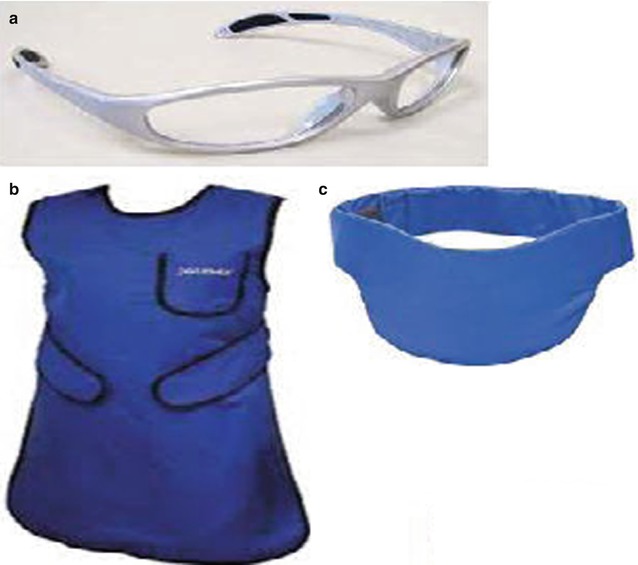Fig. 7.1
Illustration of how the largest amount of radiation is produced by scatter near the X-ray source: (a) position of the X-ray tube above should be avoided; (b) by positioning the X-ray tube below the patient, the amount of scatter to the surgical team is reduced; (c) in the lateral position, the radiation scatter is less on the side of the X-ray receiver
1.
Shielding: The surgical team should use personal protective equipment in the operating room (Fig. 7.2).


Fig. 7.2
Personal protective equipment used in operating room: (a) Leaded glasses (0.75 mm of lead equivalent), (b) leaded apron (0.5 mm of lead equivalent), (c) thyroid shield (0.5 mm of lead equivalent)
2.
Distance: As dictated by the inverse square law, the exposure to radiation is inversely proportional to the square of the distance to the source. Therefore, the surgeon and other personnel should be located as far away as practical from the radiation source during fluoroscopic procedures [15]. When possible, the surgeon should work on the side of the X-ray source and not the X-ray emitter.
3.
Fluoro Time: Minimize the beam-on time when using fluoroscopy. Use good coning techniques to narrow the beam and avoid magnification mode which has a higher radiation output. Use spot images, rather than continuous fluoroscopic images, whenever possible [15].
7.2 Conclusion
Understanding the physics of radiation and the biologic effects of radiation exposure, a surgeon can minimize the health risks to himself/herself and reduce the risks to the surgical team and patient. Proper personal protective equipment should always be utilized and specific steps should be taken to reduce fluoroscopic time and increase the distance from the radiation source when performing spinal procedures.
References
1.
NDT Education Resource Center, 2001–2012, The Collaboration for NDT Education, Iowa State University. Available at www.ndt-ed.org/EducationResources/CommunityCollege/RadiationSafety/theory/nature.htm
Stay updated, free articles. Join our Telegram channel

Full access? Get Clinical Tree








